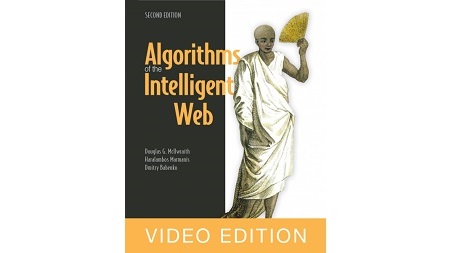
English | MP4 | AVC 1280×720 | AAC 44KHz 2ch | 7h 43m | 1.63 GB
Algorithms of the Intelligent Web teaches you how to create machine learning applications that crunch and wrangle data collected from users, web applications, and website logs. Key machine learning concepts are explained with code examples in Python’s scikit-learn. This book guides you through algorithms to capture, store, and structure data streams coming from the web, and extract real value from data. You’ll explore recommendation engines and dive into classification via statistical algorithms, neural networks, and deep learning.
Valuable insights are buried in the tracks web users leave as they navigate pages and applications. You can uncover them by using intelligent algorithms like the ones that have earned Facebook, Google, and Twitter a place among the giants of web data pattern extraction.
Inside:
- Introduction to machine learning
- Extracting structure from data
- Deep learning and neural networks
- How recommendation engines work
Table of Contents
01 Building applications for the intelligent web
02 An intelligent algorithm in action – Google Now
03 Further examples of intelligent algorithms
04 Classes of intelligent algorithm
05 Predictive analytics
06 Evaluating the performance of intelligent algorithms
07 Important notes about intelligent algorithms
08 Everything is not a nail!
09 Extracting structure from data – clustering and transforming your data
10 Data, structure, bias, and noise
11 The curse of dimensionality
12 K-means
13 K-means in action
14 The Gaussian mixture model
15 The Gaussian mixture model
16 The relationship between k-means and GMM
17 Principal component analysis
18 Summary
19 Recommending relevant content
20 Distance and similarity
21 A closer look at distance and similarity
22 How do recommendation engines work
23 User-based collaborative filtering
24 Model-based recommendation using singular value decomposition
25 Recommendation using SVD – choosing movies for a given user
26 Recommendation using SVD – choosing users for a given movie
27 The Netflix Prize
28 Evaluating your recommender
29 Classification – placing things where they belong
30 The need for classification
31 An overview of classifiers
32 Statistical classification algorithms
33 Fraud detection with logistic regression
34 From linear to logistic regression
35 Implementing fraud detection
36 One-hot-encoding
37 Are your results credible
38 Classification with very large datasets
39 Case study – click prediction for online advertising
40 The exchange
41 What is a bidder
42 What is a decisioning engine
43 Click prediction with Vowpal Wabbit
44 Preparing the dataset
45 Testing the model
46 Complexities of building a decisioning engine
47 Deep learning and neural networks
48 The perceptron
49 A geometric interpretation of the perceptron for two inputs
50 Multilayer perceptrons
51 Activation functions
52 MLNN in scikit-learn
53 Going deeper – from multilayer neural networks to deep learning
54 The Bernoulli Restricted Boltzmann Machine
55 RBMs in action
56 Making the right choice
57 The theory
58 The code
59 Multi-armed bandits
60 Bayesian bandits in the wild
61 Factors impacting the Bayesian bandit
62 A_B vs. the Bayesian bandit
63 The future of the intelligent web
64 Personalized physical advertising
Resolve the captcha to access the links!